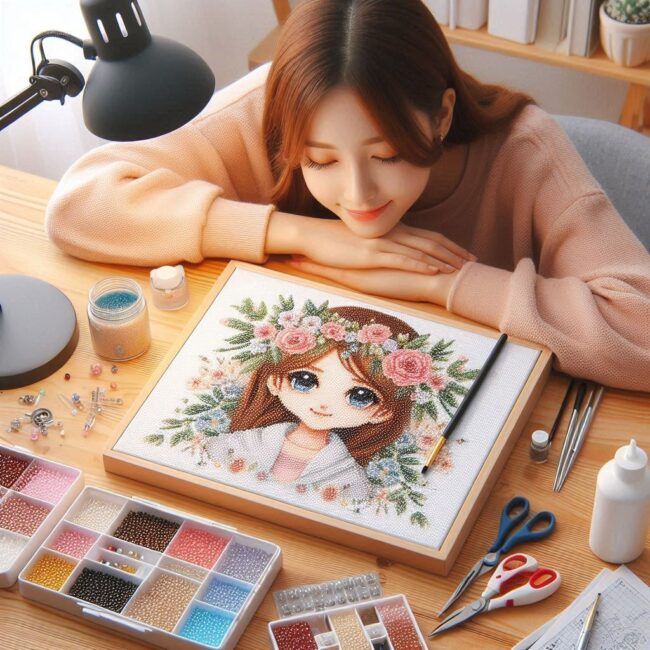
Diamond painting is a popular hobby, but it’s easy to make mistakes, especially when working with painting with diamonds kits. These kits often include tiny diamond-like beads that must be placed precisely on a canvas, leading to common errors such as using the wrong colors or misplacing beads. To fix mistakes without ruining your artwork, one effective method is to gently remove the misplaced diamond with tweezers and replace it with the correct one.
Another issue that crafters face is dealing with glue overflow or an unsticky canvas. If there’s glue overflow, washi tape can be used around the edges to prevent damage to the rest of the canvas. When the stickiness fades, a touch-up with a specialized adhesive like Diamond Dotz glue can refresh the surface, making it sticky again for the reapplication of beads. Having a variety of diamond painting kits for adults can help guarantee you have the right tools and materials to address these challenges effectively.
Keeping your work area clean can also minimize mistakes. Gently cleaning the canvas surface with a soft cloth removes dust and avoids disturbing the glue or beads. Following these straightforward methods can help maintain the beauty of your diamond painting and allow you to enjoy the craft with confidence and satisfaction.
Identifying Common Diamond Painting Mistakes
In diamond painting, achieving a perfect result requires avoiding some common errors. These include using mismatched diamonds and creating an uneven application, crooked lines, and unwanted debris.
Mismatched Diamonds
Mismatched diamonds occur when the pieces used don’t match their assigned codes on the canvas. This mistake can disrupt the overall appearance, causing unintended patterns or colors.
To prevent this, double-check the diamond shapes against their corresponding codes before application. Keeping diamonds organized by color and shape can also reduce confusion. If a mismatch is detected early, carefully removing and replacing the incorrect diamonds is important. This guarantees the design remains true to its original vision.
Uneven Application
Uneven application of diamonds can result in some areas looking more raised or sunken than others. This usually happens when varying amounts of pressure are applied during placement.
Maintaining a consistent technique helps in applying uniform pressure. It’s useful to press gently but firmly, using a flat tool like a roller to level the surface. If the uneven application is noticed too late, removing misplaced diamonds and carefully reapplying them can help even out the texture, creating a smoother appearance.
Crooked Lines and Sections
Crooked lines and sections can easily occur if diamonds are not aligned properly on the canvas. This issue can distort patterns, making the artwork look untidy.
Using a straight edge or a ruler during application can help keep lines straight. It’s important to align each diamond carefully next to its neighbor, checking alignment frequently. If crooked sections appear, they can often be corrected by adjusting diamonds before the adhesive fully sets. This can preserve the visual integrity of the design.
Dust and Debris on Canvas
Dust and debris can settle on the canvas, affecting the adhesive’s stickiness and the clarity of the design. To prevent this, it’s advisable to work in a clean, pet-free environment.
Covering the canvas with protective sheets when not in use helps keep it clean. If dust or debris is detected, gently cleaning the surface with a soft, dry brush can remove particles without affecting the adhesive. If necessary, a hair dryer on low heat can reactivate the glue, allowing the diamonds to adhere properly.
Correcting Mistakes Without Damage
Diamond painting can be delicate, but mistakes happen. It’s important to correct these errors carefully to avoid damaging the artwork. This section outlines methods for safely removing, adjusting, cleaning, and securing diamonds.
Removing and Replacing Diamonds
When diamonds are misplaced, you can easily remove them using simple tools. Tweezers are often used for this purpose. Use them to gently lift the misplaced diamond off the canvas, being cautious not to harm the adhesive layer. If the diamond doesn’t budge, try using a small amount of warmth from a hairdryer to soften the adhesive slightly.
Once removed, place the correct diamond on the sticky spot. If the adhesive seems weak, consider adding a bit of Diamond Dotz glue to secure it. Always handle diamonds with care to maintain the quality of the painting.
Adjusting Misaligned Diamonds
Misalignment is common and usually simple to fix. Use a toothpick or a diamond painting pen to nudge the misplaced diamonds into the correct position. Apply light pressure to shift them without peeling them off the canvas.
For rows that are noticeably askew, a straight-edge tool can help. Press the tool against the misaligned row, nudging the diamonds into a straight line. If errors persist, slightly lift and place each diamond again for a flawless finish.
Cleaning the Canvas
Dust or debris on the canvas can affect the stickiness and appearance. To clean, keep the canvas covered when not in use, as suggested in the diamond painting tips. If dirt accumulates, use a dry lint-free cloth to wipe the area gently.
Avoid using water or cleaning products, as they may remove the adhesive layer. If the sticky surface becomes less effective, reapply a thin coat of specialized glue to restore grip. Carefully manage the environment to keep the canvas clean.
Securing Loose Diamonds
Loose diamonds can be fixed with a stronger adhesive application. If the canvas’s stickiness has faded, lightly brush a layer of glue over the area before setting the diamonds back.
Always press down firmly on diamonds when placing them to prevent loosening. You can roll a lightweight roller over the completed section to secure them. This simple action helps to confirm that each diamond is firmly attached, minimizing the chance of them shifting over time.
Conclusion
Fixing mistakes in diamond painting can be simple with the right tools and techniques. Always keep a pair of tweezers handy for precise removal of misplaced diamonds. Consider using washi tape to protect canvas edges and prevent glue overflow.
A hairdryer set on low can help when the adhesive loses its stickiness. Clear glue applied through a thin nozzle also works well.
Sorting diamonds by color in labeled containers minimizes confusion. By using these methods, artists can enjoy a flawless and satisfying diamond painting experience.
